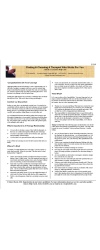By Marta Driesslein
Editor’s Note: There are a number of approaches to influencing others. In this article Marta Driesslein uses the servant leader perspective developed by Greenleaf to suggest how leaders can more effectively influence others.
What you want done, gets done when you put your people first. They’ll reward the sacrifice you make for them by making your reality, theirs. Start with a vision. Execute with a purpose. Yield the right of way.
Relinquish your need for power to control your people and you’ll win the battle for influence. Former U.S. President, Dwight D. Eisenhower observed, “Leadership is the art of getting someone else to do something you want done because he wants to do it.”
Ignite great potential in others by deliberately and strategically changing your mission’s aim and its execution to be about them, not you. You’ll exponentially achieve much more through multiplication, than by going solo. One seed falls to the ground, dies, and its capitulation results in production of fruit and more seeds. It is a continuous cycle of regeneration. So it is also to increase influence.
Historically, great leaders are first, humble servants. Get things done through others, put people over popularity, and you’ll unleash a force that changes a world. Consider one who did. Of all the jobs he could have chosen, he opted to be a lowly carpenter. Of all the paths he could have traveled, he purposed to walk the road to humility. They wanted him to be a king. He chose to be a servant.
Labeled as the “Man of Sorrows” throughout his personal and professional life, he was well-acquainted with routine disappointments, misunderstandings and frustrations. A humble resident of ancient Nazareth, whose life radiated others-oriented sacrifice, he enigmatically became a life-changing influence. He was the epitome of what “One-Minute Manager®” author, Ken Blanchard calls a “Servant Leader” because his mission transformed from the inside; the thoughts and actions of those around him. His endeavors were never self-serving.
A servant leader masters the skill of wood crafting. Whether in human resource development or in forming a work of art, there’s a mind-meld, an oneness that must occur between the crafter and the entity being formed. Unity of vision, not force transforms something out of nothing; from useless, to useful.
Brute force to timber creates firewood to be discarded. Brute force to people you want to influence destroys their spirit and neutralizes their capability to become persons of passion and purpose. Carve wood or shape others; both need development time, patience and total immersion into the undertaking.
Seek balance to offset the tyranny of the urgency. Tom Buehner, Business Strategist for R.L. Stevens & Associates Inc., an international career marketing organization headquartered in Waltham, Massachusetts, develops people, organizational infrastructures, and in his spare time, as a highly-skilled woodworker, custom furniture.
He believes whether building the next effective leader, or constructing awesome wood creations, the principle of balance is the same. “You can’t use an axe to carve a sculpture, nor can you turn a tree trunk into a table, in a hurry. If you do, you’ll overlook the wood’s inherent elegance. Likewise, uncovering a person’s potential involves time,” Buehner instructs.
Maximum influence ensues smoothly and naturally when there’s time to peel layers that hide the inner core. “The trunk of a tree, the raw material of any wood craft, has many rings. Some of these layers are rigid, some are soft. To reveal its best qualities, you must take time to really study what you have before you and envision the end-product. The work of transforming the wood needs to be done non-violently and patiently to lower the impact of the change and to receive from it in exchange, malleability. It’s the same canon to productively win over and empower your people.” Buehner says.
People don’t care how much you know until they know how much you care. Influence others to accept change by removing self-interest. Make sure what’s shared with them is edifying and beneficial. Create an unhurried environment that allows them to own their success through systematic positive affirmation.
When asked what role communications play in effectively influencing others, Buehner states from his Carmel, Indiana office, “It is less important to get your point out than it is to get your point across.” The intent of your message must equal the impact it had on them. Make sure your intent is clearly understood. Ask:
. “What did you hear me say?”
. “How do you see me helping you accomplish this?”
“Communication breaks down between leaders and those they influence when the intent is unrecognizable,” Buehner adds. “If you seek first to understand, and be a role model for others in your service to them, your message becomes a powerful leadership development tool. Duplicate yourself in your people by earning their trust, respect and accord. They’ll become more pliable and less resistant to change.”
Want a better way to permanently influence others? Remember:
. To shape you must seed
. To serve you must sacrifice
. To teach you must be taught
. To influence you must immerse
. To produce you must cultivate patience
People ascend to become what you want them to be if you allow them the opportunity to be who they are. Leadership requires the courage to let go of certainties. See inside yourself and others to visualize the end-product without prejudice or presumption.
Stop striving to be on top. You won’t lose your identity by yielding; you’ll find it – finally.
Marta Driesslein, CECC is a management consultant for R.L. Stevens & Associates Inc. http://interviewing.com/
For over 24 years R.L. Stevens & Associates has been the Nation’s most successful privately-held firm specializing in executive career searches generating quality interviews through both advertised and unadvertised channels.
Servant Leadership: The No-Thunder Approach to Quietly Influencing Others






